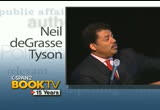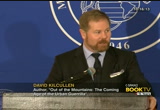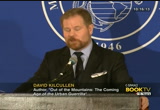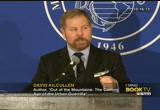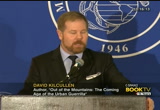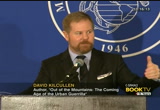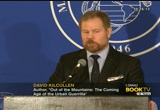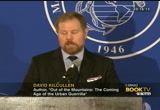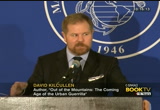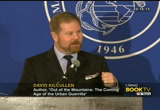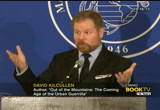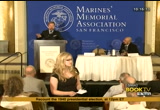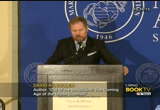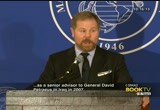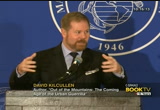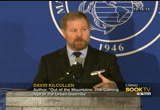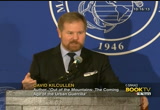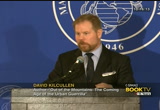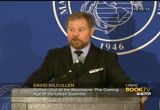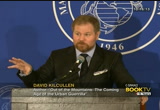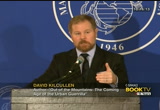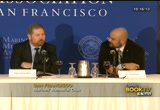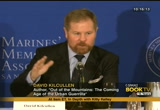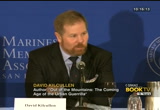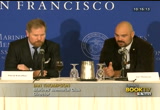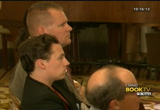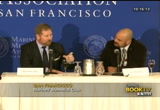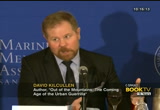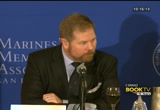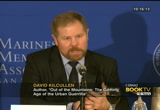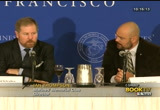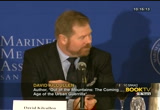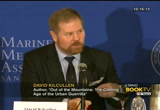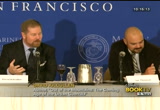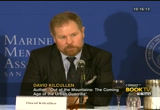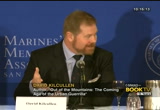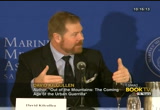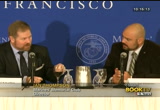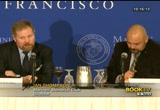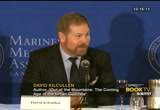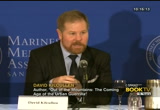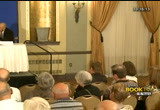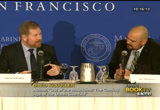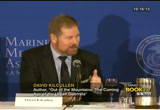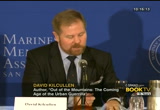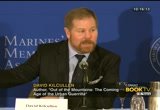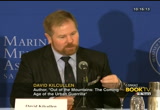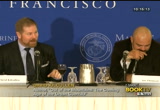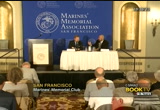tv Out of the Mountains CSPAN November 9, 2013 8:00am-9:01am EST
8:00 am
>> [inaudible conversations] >> author and astrophysicist neil degrasse tyson on america's call for engineers. >> as nasa's future goes, so too does that of america. and if nasa's healthy, then you don't need a program to convince people that science and engineering is good to do, because they'll see it writ large on the paper. there'll be calls for engineers to help us go ice fishing on your rope pa where there's an ocean of water that's been i lliquid for years. look at the nasa portfolio today. it's got biology, chemistry, fezzics, geology -- physics,
8:01 am
mechanical engineers, electrical engineers, all the s.t.e.m. fields, science, technology, engineering and math represented in the nasa rfl. a healthy nasa pumps that. a healthy nasa is a fly wheel that society taps for innovations. >> over the past 15 years, booktv has aired other 0,000 -- over 40,000 programs about nonfiction authors. booktv every weekend here on c-span2. >> here are some programs to watch this weekend on booktv. piers morgan talks about his book, "shooting straight: guns, gays, god and george clooney." then at 9:15 p.m., a book party for ann coulter's "never trust a liberal over 3, especially a republican." tomorrow at 5 p.m. eastern we bring you a collection of booktv programs on american espionage and intelligence. then at 9 p.m. eastern, "after
8:02 am
words" with husain haqqani, author of "pakistan, the united states and an epic history of misunderstanding." visit booktv.org for this weekend's television schedule. >> you're watching booktv. next, david kilcullen argues that wars over the next decades will largely be fought in underdeveloped areas of the middle east, africa, latin america and asia. this is about an hour. of. [applause] >> so it's wonderful to be back. and, you know, i wrote this book, right? so i thought i would give you a little bit of some of the major ideas that are in the book until, essentially, i get tired of talking about it and i see your eyes starting to glaze over, and then we might go to q&a. i'm in the fifth week of going
8:03 am
around giving, basically, the same talk about the book. so i'm pretty tired of it. [laughter] what i thought i'd do is just kind of move past that and try to have a bit more of a conversation. i think this is a very engaged group, and previously when i've spoken at the marines memorial club, we've talked about the bigger geopolitical and sort of picture. so, to me, that's the interesting bit. i'm going to try to throw out exactly enough that we have something to talk about. so let me be sort of give you the background as to why i wrote the book and the main ideas that are in it. i started writing in september of 2009 right after the most recent time i got ambushed in afghanistan, and it was one of these classic afghanistan ambush scenarios. most people in afghanistan -- in eastern afghanistan anyway, live
8:04 am
in mountain valleys. they live in these little villages strung out along the floor of valleys. nobody really lives high in the mountains, and there's usually only one road that runs down the middle of the valley. so if you go up that valley in the morning, by 4:00 in the afternoon, everyone knows exactly -- can people hear me all right? by 4:00 in the afternoon everyone knows exactly where you're going to be. so i got ambushed at about 4:00 in the afternoon, and i remember thinking to myself, this is a pretty bad ambush, you know? i've been involuntarily in a lot of ambushes over the last decade or so and, actually, i taught ambushing at the tactics school as an infantry instructor. so i was thinking to myself, you know, if these guys were my students, i'd probably fail them. it was badly put together. [laughter] they were having a bad day or what's going on? and i realized after about a day
8:05 am
of thinking about it, this was not a taliban ambush at all. what this was was a particular village in the valley that was pissed about how much aid we'd given to other vellages -- villages, and they were giving us a message. which seems like a crazy overreaction, right? but if you spend any time in afghanistan, you'll know that happens all the time. and it turns outta the assistance we give to afghanistan -- which is about 14 times the size of the annual afghan budget -- is actually responsible for a very substantial amount of the violence that we see on the ground. i'm going to give a shout out to will upshire and john to begin roginsky for trying to pull apart this surface layer of what you see in the conflict and look beyond and behind that to what's actually going on that you don't necessarily see, you know, immediately as you look at the violence. what i've tried to do in the
8:06 am
book is to start with that conversation that i was having in my head in afghanistan in about 2009 where i started to say, you know what? there's a deeper level here than just counterinsurgency doctrine. this is not just about an insurgency that's fighting a government, it's also about a bunch of villagers trying to gain over other villages, and it's also about the sort of dynamics of conflict that are common to not only insurgency, but also gangs and militias and all kinds of nonstate armed groups that compete to control populations, essentially, across the planet 24/7 whether you be in a war zone or not. but as i wrote the book, i really started to realize that what we're doing in afghanistan is something of a geographical fluke. and that's what, actually, most of the bookended up being about. if you hook for the last ten years -- look for the last ten years at what we've been doing,
8:07 am
we have gotten really, really good at dealing with nonstate armed groups in a very traditional, very xenophobic society in remote rural villages in this kind of landlocked, mountainous environment like the environment where i got ambushed where the population density's very low, the level of connectivity is basically nonexistent, and people are kind of scattered in these little remote outposts. if you look to the future of the to planet and you think what's actually going to happen after afghanistan is over and after we move on to the sort of next round of conflict, what you find is that that's not what the future of the environment is going to look like at all. we're going to be much more in an urban littoral that is coastal and very, very highly connected environment. we'll be doing a lot of the same things we've been doing for the last daled. 80% of conflict across the planet is and has been irregular in nature. one of the main combatants is
8:08 am
almost always a nonstate armed group, and that goes right back to the end of the napoleonic wars in 1815. more precisely, in u.s. military history there's a specific and repeated pattern that we do a large kale or long duration insurgency or stabilization operation about once every 20 to 25 years, and we do little ones -- sort of the size of kosovo or sear raleigh eurozone -- about every five years, and it's completely independent of policymakers' preferences. i heard somebody say the other day, well, didn't the president already say we're going to get out of this business? i'm like, he did. he's the seventh president in the last 80 years to make basically the same statement, and there's no rule on how often we do this stuff. so looking forward, we're going to be doing kind of more of the same stuff. but the environment in which we're going to be operating
8:09 am
looks very different. so four big factors drive that environment, and i've tried to think about what is the shape of the future environment and what impact will it have. and three of them are old, one of them's new, and it's the fourth one that i really want to focus on. let me cover the first three just to get them out of the way. so the four factors are urbanization, population growth, littorallization which is the tendency for things to cost around coastlines, and then connectivity which is the new factor. so if we start with population growth, at the beginning of the european industrial revolution in the middle of the 18th century, the population of the planet in 750 was about $1750 was about 17 million people. by 1900 we got to 1.5 billion people. we then doubled in only 60 years to three million. we doubled again to hit six billion by the last century, and
8:10 am
we've added slightly more than a billion, so today the population of the planet is roughly seven billion, so you see this accelerating pattern of population growth since the industrial revolution. now, people who do the projections and look at where population and demographics is going suggests that we're not going to keep rising at this same level forever. we're going to top out at around the middle of the century at about nine and a half billion people on the planet, but that's still about two and a half billion more people than we have now. in that same time frame, we're likely to see a reasonably or really significant level of urbanization. so again, if we go back to the industrial revolution, in 1800 about 2% of people lived in a city of a million or more. so 2% of the people on the planet were in a large city. by 1900 it was 10%, by 1950 it was 25%, by 2008 it was 50%, and the projection is we're looking at somewhere around 75% of
8:11 am
people on the planet living in a major city by the middle of this sent re. so, again, roughly the current population of the planet will be the urban population by the middle of the century. the third factor isly to havallization, and it's based, i think, just in the mechanics of moving heavy stuff that most cities have traditionally been on coastlines. if you look at megacities in particular, ten million or more, 21 out of the 25 largest cities are east directly on a coastline or on a major river delta. there are only four megacities that are not, moscow, beijing, tehran and mexico city. all the other major ten million cities or more on the planet are coastal cities. why is that? because it's a lot easier to move heavy things by water than land, so trade has traditionally been sea borne or river borne, and so cities have tended to
8:12 am
aggregate around logistics hubs. and so as a consequence, because people move to existing cities, already the population of the planet is very heavily littoral. 80% of the people on the planet today live within 50 miles of a coastline. so lit to haval, urban, crowded. those three factors extraordinarily well understood 20 years ago. and the marine corps in particular had guys like general meyer from the this club or general -- [inaudible] who talks about the three-bloc war. there were guards in the army like ralph peters, sort of military theorists of the 1990s who wrote all about this stuff, you know, way back. very, very well understood. but what's happened is in the ten years or so since 9/11 or the 12 years since 9/11, two things have happened. one, the military has been dragged off into this environment that i've been talking about, the landlocked, remote, rural environment of afghanistan. and secondly, the planet has
8:13 am
changed in that time. in the year 2000, there were only 30,000 cell phones in nigeria. today there are 113 million. when i was doing my field work in mogadishu for the book, i was walking around on the street essentially interviewing people, 24% of somalis own and use a cell phone. twenty years ago last week there was a big fight in mogadishu that's been memorialized in a movie called "black hawk down." that happened around a major market in downtown mogadishu. when i was there, i was talking to traders in that market where the somali schilling -- which is the currency that's survived for 20 years without a astronaut or central bank -- is traded on a floating interest rate. and they have computers set up, they're on the internet, they understand the international currency rates, and they trade the currency on a currency trading floor on the bottom
8:14 am
floor of that market, and five times a day they update the trading rate of the somali schilling, and they fire it out by text message to several thousand traders who are all out in the city, and that's how they work the trades that they do. now, somalis have always been traders, but until recently they weren't trading, you know, international stocks or managing remittance money in st. paul, minnesota, or scandinavia. that's what we see now. and, in fact, a lot of what i saw on the ground supported something a lot of economists are saying now, which is access to the international trading economy has become one of the major elements in urban growth. it's replaced agricultural surplus as one of the reasons why people move to cities. thinking about it in sort of scientific terms, it's kind of like a gradient where you've got a salty solution on one side of the a membrane and a nonsalty on the other, ions are going to migrate from one side to the other. if you have a connectivity
8:15 am
differential, people are going to move to where the connective is. and that's what we're seeing. because if you want to be plugged into the international economy in the way that people in mogadishu are, you've got to be if mogadishu where there's connectivity. you can't be out in the countryside in somalia. so we've seen this really significant movement of population to cities that's driven in part by connectivity. and that connectivity actually shifts and changes the way that conflict happens. i'll give you two examples of that, and then i'm going to sort of summarize with some ideas about how to think about the environment. one of them is libya and the other one is in syria. so in libya in 2011, there was a very major fight in a coastal city, and the french had a french naval task force offshore ready to intervene in the conflict. but they didn't really know very much about what was going on on the ground. this is a coastal city with an
8:16 am
urbanized population, and since 2003 libyans have exploded in access to cell phones, satellite phones and the internet. libyan school kids were getting shot by snipers as they were trying to move around the city, so a bunch of libyan schoolgirls began to use google earth and android cell phones to plot the locations of regime snipers. so they would put pins on the map to say, hey, a sniper in this building, don't go down that street. the french, sitting offshore, start to see all these pins appearing on google earth, and they were like, what is this? they figured out these a regime positions. so they started, obviously, to bomb the regime positions. when the school kids realized, hey, if we mark something on the map, the french are going to bomb it, they went out and marked every regime position they could find, and they would start taking them down, and they would disappear again from google earth.
8:17 am
so if anybody's a targetter in the audience, what we had was a completely self-synchronized, crowd sourced bomb assess system. we've got school kids doing this on the ground because testify access to connectivity. that would literally have been impossible three or four years ago. the technology wasn't there, and the level of connectivity wasn't out there. as far as i can tell talking to kids on the ground and talking to to people that were in the french task force, at no time did they ever talk to each other. they started to figure it out based on what they could see together looking at google earth. second example is a little more, is a little more analog. in syria last year -- we do a lot of work in syria for a couple of aid agencies and an ngo -- our guys started to see these little armored vehicles appearing. one of them was about 6 feet long and about 3 feet wide. it was built on a mini minor chassis with armor welded to the
8:18 am
outside. this thing didn't have a turret, what it had was a machine gun mounted on top with an electric motor so it could be controlled remotely from inside. it had a series of video cameras mounted on the outside, an action camera on the very top, and inside was a flat screen tv, and the whole thing -- both the driving of the vehicle and the control of the weapons system -- was run through the flat screen television via a gameboy game controller. this was built in a backyard workshop by a bunch of guys belonging to the free syrian army. i showed this to some army guys about six months ago, and they said, well, that doesn't make a lot of sense to build such a tiny armored vehicle that only has a machine gun on it. but if you think about aleppo, which is where this was built, if you try and take a bnp which is the soviet vehicle that the regime uses, down the street, you're not getting there because
8:19 am
these streets are literally 4 or 5 feet wide. it's not going to see them, because they can't get there. it's designed specifically to operate in the back streets of an old, medieval arab town against infantry who can't maneuver because they don't have the ability to bring tanks. this is perfectly adapted to the environment. again, the technology to even build this thing wasn't out there until about five years ago, but now what you're looking at is a very tech-savvy, technologically literate population because they have access to things like the sorts of tools and systems you would need to make a tank in your backyard. again, something that's not out there in afghanistan, but what we see in most of the environments where we're likely to operate, urbanized, technically-savvy population. final example, in the u.s. state of georgia in may of 2011 a 15-year-old ninth grade kid looked at the libyans and thought, you know, these guys
8:20 am
don't really know how to use the weapons systems they're capturing from the regime, so he crowd sourced in about 48 hours a bilingual arab/english ak-47 manual to teach the libyans how to use this weapons they were capturing. he got people that could speak arabic and pulled together this document. that's the major document used across syria in the fighting, because neither syria nor libya were gun cultures. everybody knows how to fire a weapon. once i was sitting with an afghan tribal elder, and i asked him about, you know, where the ied techniques come from, and he said what do you mean? he called over his 15-year-old son and said make me an ied. they just know how to do it. people in libya and syria don't know how to do it. they didn't have that background with. but now you've got a situation
8:21 am
where a kid in the united states can take 48 hours and pull together a manual that's now the dominant document that people use, and people download this off the internet, and it's one of the key elements of how people operate in syria. so i don't want to belabor in this point so too much, but i tk not only do we need to reengage with the urban environment because we've been distracted by ten years of doing something that's not going to be the future norm, but also in that time the world's changed, and it's dramatically more connected than it ever was. so how do we understand that? and this is the sort of topic that i'll end on. how do you understand an urban environment that's under massive stress that's producing violence and producing all kinds of other problems in and this is a pressing issue not only for people that live in syria, but for us. because this is something that's going to be happening basically across the planet. and i go back to karl marx, actually. weirdly enough. so marx, whatever else he was, he was a social scientist, and
8:22 am
he was looking at european cities at the end of the first 100 years of the industrial revolution. so berlin and london and all these places that he was looking at were experiencing many of the same things that we see in third world coastal cities today. and so he looked at, you know, the way that rapid urbanization and marginalization of communities and people getting alienated from the various systems that they need to access in order to survive, how that affects people. and when you take that and apply it to what you see on the ground in the third world today, actually a lot of similarities. but in the '60s, 1960s, a guy took one of marx's ideas, the idea of urban metabolism, and wrote an article that's become very seminal in urban ecology which is called the metabolism of cities and basically says just like a body has a metabolism, a city has a metabolism. various intakes, you know, carbon, fuel, air, people. and as they come in, they get transformed by various
8:23 am
processes, and it produces like the biomass of the city and the energy that the city needs to function, but it also produces toxic waste products, and the city needs to have the carrying capacity to metabolize or deal with those by-products, or you're going to see the buildup of pollution. and this has become a really common analytical procedure in ecology now looking at an urban environment and running a material flow analysis to understand whether that environment has the care and capacity to deal with the flow that it's experiencing. what i've done in the book, and i have a number of case studies ranging from jamaica to mumbai to various other places that i went for the book, what i've done is a nonmaterial flow analysis. so instead of looking at carbon and water, looking at things like money and drugs and weapon systems and information and how they flow through an environment and what kinds of toxic by-products get generated by that, and what are the ways that a city can use to cope with those flows. and where i come down on this,
8:24 am
in the end, is counterparadox call. it's that if you look at the problem set, the military really doesn't figure in your answer, right? there's really no military solution to the problem of rapid, unplanted urbanization across two-thirds of the planet which is going to soak in, you know, three billion new people in the next generation which is the same number of people that it took all of human history to generate right up until 1960. you could put in a marine regiment or an air force expeditionary air wing into one of those cities, and it would just disappear. we're talking about, you know, cities that will have 25 million people by 2040, the entire west coast of india being one single city, giant cities that you just can't engage with in a traditional military sense. by the way, there is a detailed appendix in the book, but i think there's really no solution
8:25 am
that involves the military going in. so a problem focus doesn't result in a military solution. that's like looking at a big city and saying the solution here is fire prevention? that doesn't help you if you're in the fire department, right? if you're in the fire department, your job is to fight the god damn fires when they break out, right? so you have to think, okay, what do i do when fire prevention fails? so the paradox is if you're in the military -- although there's not a likely solution to all of these things -- there's a dead certainty that our political leaders will continue to send us into these environments because that's what they've been doing for the last 200 years. so if you're in the military, you better understand how to operate in a very crowded, urbanized, coastal environment against a nonstate actor who has access to democratized technology and connectivity that makes that adversary
8:26 am
dramatically more lethal than anything we've really ever encountered before. so that's the environment that the military needs to be thinking about, and it has some really significant implications for the way we structure and the kinds of things we buy and the way we operate, and that's one whole side of the discussion. but the other side of the discussion is what are we doing about the problem? because the solution isn't necessarily military. and i think that it's much more a matter of resiliency and community-based co-design rather than governments coming in, patting people on the held, sort of telling them to sit down and shut up while we give them the solution. and i can talk about some of the things we have done in my little company in africa and latin america trying to sort of test some ways that we might operate. here in san francisco we've got a great company called idea which pioneered a thing called human-centered design and has focused a lot on what i would call co-design, how you get outsiders who have certain kinds of technical knowledge and put them together with a community
8:27 am
that understands a problem and comes up with innovative solutions that neither side could come up with. and i think some of the things are just brilliant. my challenge to them and what my people that work for me do every day is how do you do that in an environment where people are shooting at you? where the level of violence so high that you just can't sit down with people and have a conversation. that's the sorts of places that we work, and unfortunately, i think it's where people in the military and law enforcement and in the aid community really need to be focused in terms of thinking about the future conflict environment. because i've been very down for the last 20 minutes or so, i'm going to end on an up note which is it's not all bad, right? we're talking about three billion more people in urban environments by the middle of the century. not only could that potentially be very good for the planet, right? it could really reduce pressure on the environment in some ways, but also we could be talking about two billion more people in the global middle class by the middle of the century, lifting people out of poverty, access to
8:28 am
education, access to the means of economic prosperity. there's all kinds of upsides to in this. if you're in business, there's a massive business opportunity here. i mean, these cities haven't even happened yet, and we're talking about the entire population of the planet in 1960 is going to need all kinds of stuff just to get by in these big cities. so there's a significant upside to this. and, in fact, there's a lot of good research data which suggests as cities get bigger, their adaptive capacity and their ability to handle these kinds of problems actually increases faster than the scale of the problems. but there are certain things you've got to have in place if that's going to occur, and one of those is the ability to free up adaptive resources and make people more resilient. so i think the solution is, ultimately, not to be thinking about how do we stop this human tide that's going to be flowing into environments on coastlines in the developing world in the next generation, it's thinking about how do we teach people to swim. how do we think about urban resiliency in a different way that sort of exploits the kinds of adaptive capacity that are
8:29 am
already out there and kind of helps people unlock that as a way to engage with these problems. so i hope i've given you guys enough to start a conversation. i could go on at length, but i'm, as i said, bored with giving the same talk for the last five weeks, so let's have the conversation, and i'm going to defer to you and to drive. >> great. >> do you want me to stay here or sit down? >> why don't you sit down k. i see there's some question cards. if you just case them up a little bit, somebody will grab them for you and continue to get them to come in. david, some good questions have come in on a range of subjects. one that you and i spoke about a little bit before has come up at least twice, is this curse of preparing for the last conflict, right? and one, i think, very poignant question that came in is what are some of the bad lessons that are probably going to be inappropriately weighted coming out of the iraq and afghanistan
8:30 am
experience for our military and maybe for our government as we approach problems moving forward? >> yeah. great question. well, i see two equal areas creeping into the debate right now. one of them is like counterinsurgency is the answer to the problem. counterinsurgency is just a doctrinal construct we built under fire in the last five years, and it's a human model for looking at an environment. and as the environment shifts, your model has to shift, you know? and i think we're about due for kind of a scientific revolution in the way that we think about the conflict environment because we're getting enough data now about the future environment that, you know, it contradicts our sort of basic counterinsurgency theory. but i think it's about time we started thinking about what comes next. p.m.
8:31 am
>> offers a promise of avoiding putting boots on the ground. it reminds me of classics written on war, and i apologize for quoting, but he said, "war is so dangerous that often the worst eras proceed from kind heartedness". i think some of the worst american eras in warfare succeed from trying to minimize danger and damage that conflict does. one of those effects right now is this reliance on remote forms
8:32 am
of technology to compensate for our miranda ruleness to put troops on the ground. only thing that stops human beings from fighting each other is when they lost though that they had enough and they stop fighting. if you outsource that to robots and make it so we can kill anybody we want at any time across the planet meeting our own domestic legal requirement, that could bounce back on us at some point. >> i see that. i think a related question is, you know, what tactics and what conflicts in the past has been very relevant to, you know, this world that you're foreseeing, and with that, you know, what countries are best placed because of their experiences in their established ttps, tactics, technique, and procedures, they utilize in local conflicts and for us?
8:33 am
what do you see? >> yeah. i think in iraq and afghanistan translates at the tackty call level of what comes next. to go on the record, those who have not spent a lot of time with the american military in iraq or afghanistan in the last decade or so, it's hard to realize how good they are at what they are doing. stuff that the average american battalion can do now was only in the realms of special forces five years ago. what special forces does now was hollywood five years ago. the level of capability of the military, agencies, state department, ngos on the ground is really unparallel in history. to me, one the great potential tragedies of what's coming up in we may forget everything we learned at so much cost in blood and relearn it again. i would love to make some new mistakes next time around rather than the same mistakes again. you know, that's part of this, but i think what i talk about a
8:34 am
lot in the appendix is how the urban changes conflict and how we think about the environment. it's a very, very complex, what i call a nine main challenge. not to get geeky, but the military thinks in terms of domains. we talk about the land, maritime, and air, but if you think about it, the environment, you talk about nine domains. the subterrainian, land surface, superstructure, high-rise, the urban canyon 20 years ago, that rooftop environment, there's the aerospace, cyberspace, and offshore, there's a maritime aerospace demand, sea surface, subsurface, and seabed, harbors, creeks, and rivers that are in the middle where there's overlapping effects of all the different domains. the way we thaw about operating
8:35 am
in the future environment is not necessarily going to cut it in the nine domain environment. in particular, and i'm in a marine establishment here, the marine corp operation is extraordinary well dupedded for an environment where you don't have lots of urban environments; right? once the entire sea board is urban, ship to objective maneuver will be different because there's not the space to get into. for the navy, sea bases, basically ten days, ten nautical miles, one, two selective forms, and a way of running logistics into the environment that means you don't have to see the port or airfield and stay at stanoff zaps, that's not going to work when you're going into an environment primarily because you have to be there for a long period of time to engage with an urban structure that's not coded. for the army, we're good in the last decade of running logistics through a contracting mechanism
8:36 am
going into the environment, and we take up the things we need from the environment by means of contracts. you know, fuel, water, food, and so on, and logistics is the key thing here. tactics is easy. logistics is the critical issue. the -- that's not going to work when the reason you go into the environment is precisely because there's not enough stuff; right? there's a conflict emerging because of the way urban environments have overstretch to go in contracts saying, hey, we want to buy up all the stuff that's already scarce that you're fighting over it. it's not going to work. that's just the main issues. >> yeah, yeah. just a quick follow-up question in there that i think is interesting is, you know, who's good -- at least the first three issues; right? the connectivity is one that is a rapid change, you know, for the first three, who are experts in that in the world? >> well, the u.s. is really good
8:37 am
at operations, probably the only country in ten years with significant urban combat is the united states military in iraq. the only nation that's done any kind of urban la tore rail in the last decade is the british, and they have got good at thinking about how a threat in an urban coastal environment. i think that one of the key things that jumps out at me is how do you organize junior level commanders to operate effectively, and you're looking for a different kind of guy to run the squad or be a sergeant than you may have already in the organization. the french are really good at the way they structure and organize june your commanders, and we can get into that, if you. , but it's completely different to how we do it. what we see in counterorganized
8:38 am
crime and policing thinkers, and i talk to them and quote them in the book thought about this oarch the last ten years is relevant looking like what the brazilian police do than what the military does. >> good questions around the connectivity issue, the importance of citizen soldiers; right? the idea there's so much happening in the private sector, it's dynamic, especially in the communication age, you know, how are -- how can we incorporate the citizen soldier better in the american military and there's the question specifically on how the australian military will do that bether? >> great questions. one issue, there's a lot of things you could talk about, but one is how we use people that understand big data, and the
8:39 am
other is how we use people that understand the environments we're operating in. my academic background is political anthropology, a colonial discipline basically, doing a post graduate degree, put on a hat, go to another country, and write back a report for your white friends on how is a advantages behave. there's a book in anthropology who traveled and went into and came back and wrote an account of how things happen in new guinea. coming from the academic background, i was, like, i need to go out there, and, like, do all my own model -- you know, you don't need to do that anymore. people are connected. the environment is out there talking to us directly, and, in fact, there ought to be, if not, a crisis of confidence among anthropologists because the
8:40 am
discipline is disappearing. when i looked at the villa outside of rio, i thought, i'm going to have to walk the streets, engage, and participate in life outside the villa, which, obviously, you need to do that, and i did that in jamaica and other places, but 20 bloggers write, and one of them writes a great blog about how governments function in an environment run by gangs, written in english, easy to talk to the guy, pick up the phone. we have four teams on the ground. you don't need to put people out there. that's one element i would be sort of thinking about, how do you leverage the diaspora we have in the country with people from every country on the planet with the kinds of language, skill, and knowledge and relationships to tap into that environment to just understand
8:41 am
what's going on in the environment. again, i want to emphasize, there's no military solution here. it is about understanding what's going on. the other thing is big data. it is now possible to really understand through remote observation of honest signals in the environment of what's going on in a way it was not possible five to ten years ago; right? you can sit in a major city in honduras with the highest murder rate on the planet and fire up google maps in the morning and based on traffic patterns if you understand how to read what you are looking at, you understand which streets to avoid because of the way the traffic moves. people do that. i think there's -- i was out at google talking to engineers without how they do big data analysis, and one said, there's no solution here. i think he's right in the sense that there's no holy grail to solve the problems through big data, but it will allow people
8:42 am
that live in the environments to be more resilient; right? they can figure out work-around to exist in the environment that's growing rapidly and dominated by a group, but they can still function. i don't want to mad max under them about the future, but the, you know, i think leveraging people that come from the places where we might be likely to operate and leveraging people that can bring together fuel operations of the ground, that, to me, is the critical stuff we're note doing now that we have to do better. it's a small community within the military needs to be broader and not just the military. i mean, you know, every police department is going to need to do what the new york police department does which is have people overseas engaging with other police talking about what's going on in other environments around the world. >> yeah, certainly, this place is very involved. fleet week has become and looking at the relief and
8:43 am
disaster response and integrating federal assets with local law enforcement and local emergency responses is a component of, i think, the next question which is, you know, we've spoke about people who are experts with tactics, using design thinking, what is the governmental structure or intergovernmental structure look like to be effective in a situation like this? we're looking at military issues, policing issues, information issues, pure technology components. >> so, i did a number of case studies in the book, the mumbai attack in 2008, gang warfare in jamaica, looked at sri lanka, looked at conflicts in the arab spring, went on the ground in somalia and so on, and one of the key things that came out from all of these, you know, research efforts, was that national governments matter a lot less than we might think, and, in fact, the city rather than the nation state is probably the unit of analysis we
8:44 am
have to apply here. what happens at the urban or level of city government and sub city government matters a lot more for the outcome of the kinds of issues and what happens in the national government. good example of that is, well, two good examples, mog dish ewe is without a government for 20 years, yet the city functions basically about as well as it did before 91, which enables professors to coin the term based on observations of what happens to cities when national governments collapse. they are a great example. we think that governments create cities and if government goes away, the city collapses. research shows you that governments that create cities, domestic city, tame them, and when the government goes away, the city just goes wild and get a mad max environment that we see in mog dish ewe. we have to think about, again,
8:45 am
resiliency, not stability. stability is a systems characteristic; right? a system is stable or unstable. if we look at cities, we don't see stable systems. we see open systems that have continual input in a situation of dynamics. the capital of bangladesh is a great example. in 1950, they were 400,000 people, and today it's 12 million, will be 25 million by 2525 and a whole series of government have fixes to deal with the problems that have repeatedly been overtaken by events. by the time they could have been implemented with the coordination required at the nation state level, they already too late to effect things they were trying to change. getting it below nation state to the city and subsidy environment is important. we are getting offensive about this.
8:46 am
i look at this as an urban freckle pattern. same stuff repeated at the street block sub district, district, city, and national level, and the fixes are often similar, but they sort of -- with a twist at each level, so i think when you learn what works at the street level or works at the district level, you can model what works on other levels and that freckle pattern. >> motivation of violence is a concept, i think, is something we've seen here a little bit, and i'll pose two. one, you know, very aggressive coefficients that they talk about the disparity between the wealthy and those in need -- >> by the way, there's not a strong correlation in the literature or film research between just a straight lodge coefficient and violence. the koalation is between inability of people shot out by the system to access the system
8:47 am
rather than the fact there's a disparity between, you know, rich and poor. >> yeah, no -- >> sorry, go ahead. >> no, actually, that came up in one of these about education and leveraging education when -- >> right, yeah. >> so a place like angola with a lot of wealth; right, and the ability to create systems for education and bridge that gap. >> right. >> motivations being, seeing the grass greener on the other side, wanting it, whether there's that's wealth or influence in the country's future or organization or the environment's future, and then black market business, drugs, and arms being kind of a fuel for the violence and reason for the violence. >> actually, the single biggest motivator for violence i saw on the ground was predictability. weirdly enough. i'll explain in a minute, but the thing about a city is a system; right? you have the city with people
8:48 am
slumming, and where people settle, there's a donut-shaped ring of territory where there is now a series of slums around the old city environment. not a lot of government presence, no government services, a lot of people in there are excluded from the main stream of the economy or from politics, and there was a time there after 9/11 where we used to talk about ungoverned spaces m i don't know of anyone in the military at the time, but we had a fear of ungoverned spaces. it was like counterinsurgency and must be bad guys there. i went into the slums of africa and other places, and they are not ungoverned, but thoroughly governed, but not by the government. when that happens, a nonstate arms group emerges, and the role they play is like the police force in the center of town than it is, like, terrorists or insurgents.
8:49 am
ad -- a good example is the gang analyzed in the chapters where, you know, we got the jamaicans to mortar and rocket their capital city and invade the district in kingston in order to deal with one guy smuggling cocaine into the united states. it was part of the drunk trafficking organization. if you talk to people op the ground in jamaica, it's not a drug smuggling organization. that's not what it is. that's what it does. sells drugs to rich white foreigners on the other side, but what they do on the ground is it gets you a job, provides health support, keeps down petty crime, managing the transportation system. it's the as much by which you access things like fuel, water, and electricity. it's essentially the government; right? just like our government kills people overseas, you know, and it's a negative extraalty of the united states, those living in the big slum in jamaica, the fact that the government sells
8:50 am
drugs to rich white guys in new york city is not the main issue. i think thinking about that sort of city as a system, the main motivations for violence for most people i spoke to, getting away from a dangerous environment is unpredictable uncertainty to an environment where i know exactly what i have to do to be safe. a notary public state group comes in and sets down a rule set, a normative system saying here's the rules, if you follow the rules, i'll protect you and not hurt you. if you break the rules, obviously, you're at risk, and, basically, that seems to have a very attractive effect on populations that are kind of buffeted by uncertainty that have to know how to be safe, and when they get a clear role set, they block to that and come under the control of the nonstate armed group. the effect i think is interesting is the effect it has on politicians in the downtown urban area because that ring of territory we talk about didn't
8:51 am
used to be vacant before the slums. that's where they had food, where the area used to be for the water, and now there's nonfed arm groups with a choke hold on the city because they control a ring of territory and all the stuff the city needs to survive runs the gamet of that territory to get inside and politicians make deals with the groups in order to make the city survive. we can say it's corrupt, but i had guys say, what am i going to do? if i don't deal with the gapings, they shut the city down. there's motivations for violation, but i think it boils down to the quest in predictability in uncertainty. >> what's the relevance of traditional alliances like nato, you know, in a world that is dealing with nonstate actor repercussions? ratifications of humanitarian issues and low level violence? >> i think nato is -- even though a lot of the problems
8:52 am
happen at the city and below city level, the way that militaries and diplomatic services and ad agencies engaged in solving problems works through institutions like the u.n. and, in fact, nato, right now, think about what they are going to do post-afghanistan, and part of the conversation i've been having with people in nato is around this issue of actually afghanistan's a bit of a geographical foot. amize what we spent ten years doing, you're awesome of fighting the 9% of the people you won't fight in the future. it happens in the environment, but it's not going to require the same things we do for the last decade. i think nato, to a lesser extent the u.p., but interestingly other organizations like the world bank and the asian and african development bank started to think about how to address this stuff, and there's a program right now that we do work with in africa called violence prevention, urban
8:53 am
upgrading, people use urban design to both prevent violence from happening and figure out ways to contain the limit when it does happen. that's a great example of the u.n. sponsoring something out there that has effects even though it's not military. >> a worldwide allied marshall plan almost? >> yeah, i wouldn't go that far begin current fiscal circumstances, but it doesn't necessarily get helped by a large amount of international assistance. in fact, you know, in the last five years, private philanthropic organization overtake government assistance as the main aid patent within the world. i had an interesting conversation with the gates' foundation last year about this question. philanthropic organizations have a single focus issue like health; right? if your focus is maternal health and infant mortality, that's what you have money for and focus on. the city as a system, that's the focus now, you have a great education plan for five years from now and have an awesome
8:54 am
employment plan for 20 years from now, otherwise you just create a massive problem that bites you in the ass a generation from now which we see in a lot of the cities out in the environment. >> i'll end with this question which i think is a little of a teaser knowing what you're thinking about as well in the future. process of forgiveness and reconciliation and leadership in post conflict zones. using iraq, afghanistan, rwanda, places that have been really struck by violence, where do leaders get mandates or get mandates to do by them or by their people. >> great point. to my mind, one of the under acknowledged but important elements in afghanistan is we never effectively made peace after 2001; right? i mean, basically, every kid
8:55 am
that goes to high school in the last 80 years was taught the least effective peace treaty was after world war i. it's nothing to -- at least we invited the germans to come to our side. we never let the taliban turn up. they surrendered and tried to make peace after 2001, acknowledged the authority of new afghan government and wanted to be a part of the process, and we said basically excluded them. they came back in 2003 in part because they had been excluded from this sort of reconciliation process that never happened in afghanistan. i think, twaim, that's the missing piece. in the last chapter, i talk about initiatives that have been successful. one is lib ya women banded together and created a dynamic leading to the end of the civil war in 2003, and it's worth talking about women for a second.
8:56 am
there's women involvement in these kinds of conflicts that is important and relevant, but there's another way that i like to think about it which is economics so most of the slum environments we talk about, there's no jobs for men in these environments, and that's not accidental. that's because they are designed as dormitory environments for labor forces to work somewhere else. they do work in townships in south africa as you guys do. townships are there because the english colonial government enacted after that put them there for up married men to be labor forces for the downtown area. if you live in san jose, for example, the guy that delivers your mail does not necessarily have the money to live there. he lives two or three hours drive away, comes in, does the job, and goes back to where he lives. urban environments in africa, that's a slum; right? most of the men leave the slum every morning to go work. the only people that really stay
8:57 am
around that are male in the environment are young men, old men, or people on crime. the jobs are held by women and most businesses that do business in the environment are run by women. if you want to talk about peace building, you're missing not only 50% of the population, everyone understands that's not smart, but you are missing 90% of the economy that goes on on the ground. what happened in liberia is a bunch of muslin and presbyterian women got together created an alliance between themselves to put economic pressure on the government to shut down the conflict, and they went overseas with help from nigeria group of lawyers to put pressure on the rebel side of the conflict and force people to stop fighting, and that's one of the few examples of successful kind of bottom-up peace building we've seen, but, again, it's enabled
8:58 am
by connectivity, and i think we'll see more examples of this going forward. sorry, i think, you know, peace building, bottom up is really important, but, you know, they need an international peace keeping force by the states to come in and police the peace agreement in place; right? that does not let us off the hook. we have to be ready to get into the environments, but, ultimate,ly, the solution comes from within the society or doesn't come at all; right? you can't impose peace from people outside, and you certainly can't impose legitimacy on a political system from outside. you can't assemble a state from other states, and then bring in kind of the spark of legitimacy from outside. that's like building frankenstein's monster; right? you can animate that that walks and talks for a little while, but it goes bad. there's states out there we built that way. the spark of legitimacy comes from within the body of policy
8:59 am
itself, that's succeeding in liberia, nigeria that have managed to be resilient in the face of conflict there. libya, internally legitimate coming from, you know, this urban population that gets disregarded that's actually going to be the dominant population of the next generation. >> david, thank you very much. this concludes our portion. [applause] that was an excellent talk, an excellent talk, good discussion from the participants out in the audience. thank you. david, it will be here for a bit to sign copies of the book. i have read more than 30% of the book. i can't say i got much more than that, but it's so readable. i can't tell you how great it is, the vignettes in there, it's rich reading, so i encourage you
9:00 am
to look at it. >> if anyone has an insomnia problem, i recommend it to get you to sleep at night. [laughter] >> i don't think it works for that. >> oh, okay. >> thank you very much for coming. >> yeah. [applause] [inaudible conversations] [inaudible conversations] >> i think regardless where you are on the political spectrum, we are fortunate and grateful we live in the united states of america. it's a very unique place, and if america was considered to be a product, and we do try to sell our
100 Views
IN COLLECTIONS
CSPAN2 Television Archive
Television Archive  Television Archive News Search Service
Television Archive News Search Service 
Uploaded by TV Archive on

 Live Music Archive
Live Music Archive Librivox Free Audio
Librivox Free Audio Metropolitan Museum
Metropolitan Museum Cleveland Museum of Art
Cleveland Museum of Art Internet Arcade
Internet Arcade Console Living Room
Console Living Room Books to Borrow
Books to Borrow Open Library
Open Library TV News
TV News Understanding 9/11
Understanding 9/11
